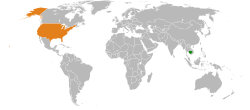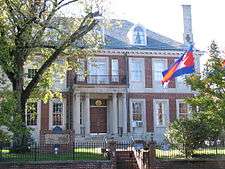Cambodia–United States relations
 |
|
Cambodia |
United States |
|---|---|
| Envoy | |
| Ambassador Chum Bunrong | Ambassador William A. Heidt |

Bilateral relations between the United States and the Kingdom of Cambodia, while strained throughout the Cold War, have strengthened considerably in modern times. The U.S. supports efforts in Cambodia to combat terrorism, build democratic institutions, promote human rights, foster economic development, eliminate corruption, achieve the fullest possible accounting for Americans missing from the Vietnam War-era, and to bring to justice those most responsible for serious violations of international humanitarian law committed under the Khmer Rouge regime.
According to a 2011 Gallup poll, 68% of Cambodians approve of the job performance of the United States, under the Obama Administration, with 7% disapproving, the most favorable opinion for any surveyed Asia-Pacific nation.[1] In a 2012 Gallup Poll, 62% of Cambodians approved of U.S. leadership, with 8% disapproving.[2] President Barack Obama's visit to Phnom Penh in 2012 makes history as the first U.S. President to visit Cambodia.
History

Between 1955 and 1963, the United States provided $409.6 million in economic grant aid and $83.7 million in military assistance. This aid was used primarily to repair damage caused by the Indochina War, to support internal security forces, and for the construction of an all-weather road to the seaport of Sihanoukville, which gave Cambodia its first direct access to the sea and access to the southwestern hinterlands. Relations deteriorated in the early 1960s. Diplomatic relations were broken by Cambodia in May 1965, but were reestablished on July 2, 1969. U.S. relations continued after the establishment of the Khmer Republic until the U.S. mission was evacuated on April 12, 1975.
During the 1970–75 war, the United States provided $1.18 billion in military assistance to government forces in their fight against the Khmer Rouge as well as $503 million in economic assistance. The United States condemned the brutal character of the Khmer Rouge regime between 1975 and 1979. However, the fact that this regime was toppled in the Cambodian–Vietnamese War by Vietnam, which the United States regarded as a hostile power, led to US condemnation of the Vietnamese invasion. The United States recognized the Coalition Government of Democratic Kampuchea (which included the Khmer Rouge) as the legitimate government of Cambodia.[3] Ben Kiernan claimed that the US offered material support to the Khmer Rouge after the Vietnamese invasion.[4] Other sources have disputed these claims,[5] and described extensive fighting between the US-backed forces of the Khmer People's National Liberation Front and the Khmer Rouge.[6]
Concurrent with these efforts, the United States supported ASEAN's efforts in the 1980s to achieve a political settlement of the Cambodian problem that would include the Khmer Rouge in the government. This was accomplished on October 23, 1991, when the Paris Conference reconvened to sign a comprehensive settlement.
The U.S. Mission in Phnom Penh opened on November 11, 1991, headed by career diplomat Charles H. Twining, Jr., who was designated U.S. Special Representative to the SNC. On January 3, 1992, the U.S. lifted its embargo against Cambodia, thus normalizing economic relations with the country. The United States also ended blanket opposition to lending to Cambodia by international financial institutions. When the freely elected Royal Government of Cambodia was formed on September 24, 1993, the United States and the Kingdom of Cambodia immediately established full diplomatic relations. The U.S. Mission was upgraded to a U.S. embassy, and in May 1994 Mr. Twining became the U.S. ambassador. After the factional fighting in 1997 and Hun Sen's legal machinations to depose First Prime Minister Ranariddh, the United States suspended bilateral assistance to the Cambodian Government. At the same time, many U.S. citizens and other expatriates were evacuated from Cambodia and, in the subsequent weeks and months, more than 40,000 Cambodian refugees fled to Thailand. The 1997 events also left a long list of uninvestigated human rights abuses, including dozens of extrajudicial killings. Since 1997 until recently, U.S. assistance to the Cambodian people has been provided mainly through non-governmental organizations, which flourish in Cambodia.
Gallery
-

Cambodian embassy in Washington.
-

The United States embassy in Phnom Penh.
-

U.S. President John F. Kennedy with Prince Norodom Sihanouk in New York City in September 1961.
-

Former First Lady Jacqueline Kennedy with Queen Sisowath Kossamak and Prince Norodom Sihanouk in 1967.
-
.jpg)
Prince Norodom Sihanouk and U.S. President Ronald Reagan in 1988 in the Oval Office of the White House
-

Senator Jim Webb meeting with Prime Minister Hun Sen on August 19, 2009, in Phnom Penh.
-

U.S. Secretary of State Hillary Rodham Clinton with Minister of Foreign Affairs Hor Namhong at the Department of State, Washington, D.C.
-

Prime Minister Hun Sen shakes hand with Secretary of State Clinton before their meeting in Phnom Penh; July 11, 2012.
-

Foreign Minister Hor Nam Hong meets with US Secretary of State Hillary Clinton in New York City in 2009.
-

Cambodian Ambassador Hem Heng presents credentials to U.S. President Barack Obama at the White House on May 20, 2009.
-

U.S. Defense Secretary Leon E. Panetta walks with Cambodian Defense Minister Tea Banh during a meeting in Siem Reap, Cambodia, in 2012.
-
.jpg)
U.S. President Barack Obama is welcomed by Cambodian Prime Minister Hun Sen at the Peace Palace in Phnom Penh, November 19, 2012.
-

U.S. President Barack Obama visits the United States embassy in Phnom Penh.
-

Royal Cambodian Navy officers observe flight quarters during the Cambodia-US Maritime Exercise 2011.
Principal U.S. Officials
- Ambassador: William E. Todd
Diplomatic missions
The U.S. embassy is located in Phnom Penh, near Wat Phnom. It is one of the biggest embassies in Phnom Penh.
See also
References
- ↑ U.S. Leadership Approval Ratings Top China's in Asia Gallup
- ↑ Snapshot: U.S. Leadership Unknown in Myanmar Gallup
- ↑ "U.S. Aid to Anti-Communist Rebels: The "Reagan Doctrine" and Its Pitfalls". 24 June 1986.
- ↑ Kiernan, Ben (April 2005). "The Cambodian Genocide and Imperial Culture". 90 Years of Denial. Aztag Daily (Beirut) & Armenian Weekly (Boston). pp. 20–21. Retrieved 15 September 2012.
- ↑ "Pol Pot's Evil Had Many Faces; China Acted Alone". The New York Times. April 22, 1998.
- ↑ Thayer, Nate (Spring 1991). "Cambodia: Misperceptions and Peace". The Washington Quarterly 14 (2): 179–191.
![]() This article incorporates public domain material from websites or documents of the United States Department of State (Background Notes).
This article incorporates public domain material from websites or documents of the United States Department of State (Background Notes).
External links
- U.S. Embassy Phnom Penh webpage
- History of Cambodia - U.S. relations
- Reagan Is Urged to End U.N. Support of Pol Pot The New York Times 10 December 1981: A17.
![]() Media related to Cambodia – United States relations at Wikimedia Commons
Media related to Cambodia – United States relations at Wikimedia Commons
| ||||||||||||||||||||||||||||||||||||||||||||||||||||||||||||||||||||||||||||||||||||||||||||||||||||||||||||||||||||||||||||||||||
| |||||||||||||||||||||||||
.svg.png)
